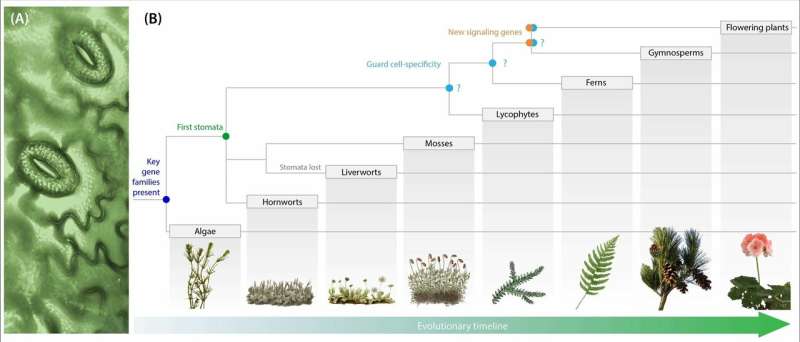How plants learned to save water

Tiny pores on the leaves of plants, called stomata, have a huge influence on the state of our planet. Through the stomata, plants absorb carbon dioxide, which is incorporated into carbohydrates, and release oxygen. But they also lose water through open pores, which can be life-threatening for plants in dry conditions.
Plants therefore have developed complex signalling pathways that optimize the opening width of stomata to match the environmental conditions. In response to changes in the availability of light, carbon dioxide and water, they can open or close these pores. How did the signalling pathways that are responsible for this regulation evolve? This is being investigated at Julius-Maximilians-Universität Würzburg (JMU) in Bavaria, Germany, in the team of the plant scientist Rainer Hedrich.
"We are currently collecting and analyzing data from different plant species," says Professor Hedrich. He explains that this research also has relevance for agriculture: "Knowledge about the evolution of these signalling pathways could feed into breeding efforts to develop crops that can grow with less water." After all, the majority of the drinking water supplied to plants via irrigation systems is lost through stomatal pores. In view of climate change, plant varieties that can cope well with drought are highly sought-after.
History of important genes reconstructed
In the journal Trends in Plant Science, JMU researchers Dr. Frances Sussmilch, Professor Jörg Schultz, Professor Hedrich, and Dr. Rob Roelfsema now summarize the current state of knowledge on the signalling pathways that plants use to regulate their water balance.
The Würzburg team has reconstructed the evolutionary history of important genes that control the movement of leaf pores in flowering plants. It turned out that most of these genes belong to old gene families that occur in all plant groups, including green algae. These gene families probably developed before the first plants colonized the land.
The researchers also found out that some specific genes that control the opening and closing of leaf pores in response to light and carbon dioxide probably only developed in seed plants or flowering plants after they had been separated in evolution from a common ancestor with ferns.
Specific signalling genes in adjustable guard cells
In their work, the JMU scientists look closely at the plants' guard cells. These two cells surround each leaf pore. When hydraulic pressure rises in the guard cells, the pores open. If the pressure decreases, the pore closes.
In the guard cells of flowering plants, the products of certain key signalling genes have unique properties or are found in much higher concentrations than in the surrounding leaf cells. The specificity of these genes is likely important for controlling the hydraulic pressure in the guard cells.
The researchers have also examined related genes using available data for the moss Physcomitrella patens. "We found out that none of the moss genes of interest were specific for stomatal-bearing tissue, but instead all these genes were also expressed in tissues without these pores," said Frances Sussmilch. Rob Roelfsema and Jörg Schultz add: "Signalling genes with specific roles in guard cells probably arose later in plant evolution after the divergence of mosses from an ancestor they share with flowering plants."
More information: Frances C. Sussmilch et al. Acquiring Control: The Evolution of Stomatal Signalling Pathways, Trends in Plant Science (2019). DOI: 10.1016/j.tplants.2019.01.002
Journal information: Trends in Plant Science
Provided by Julius-Maximilians-Universität Würzburg



















